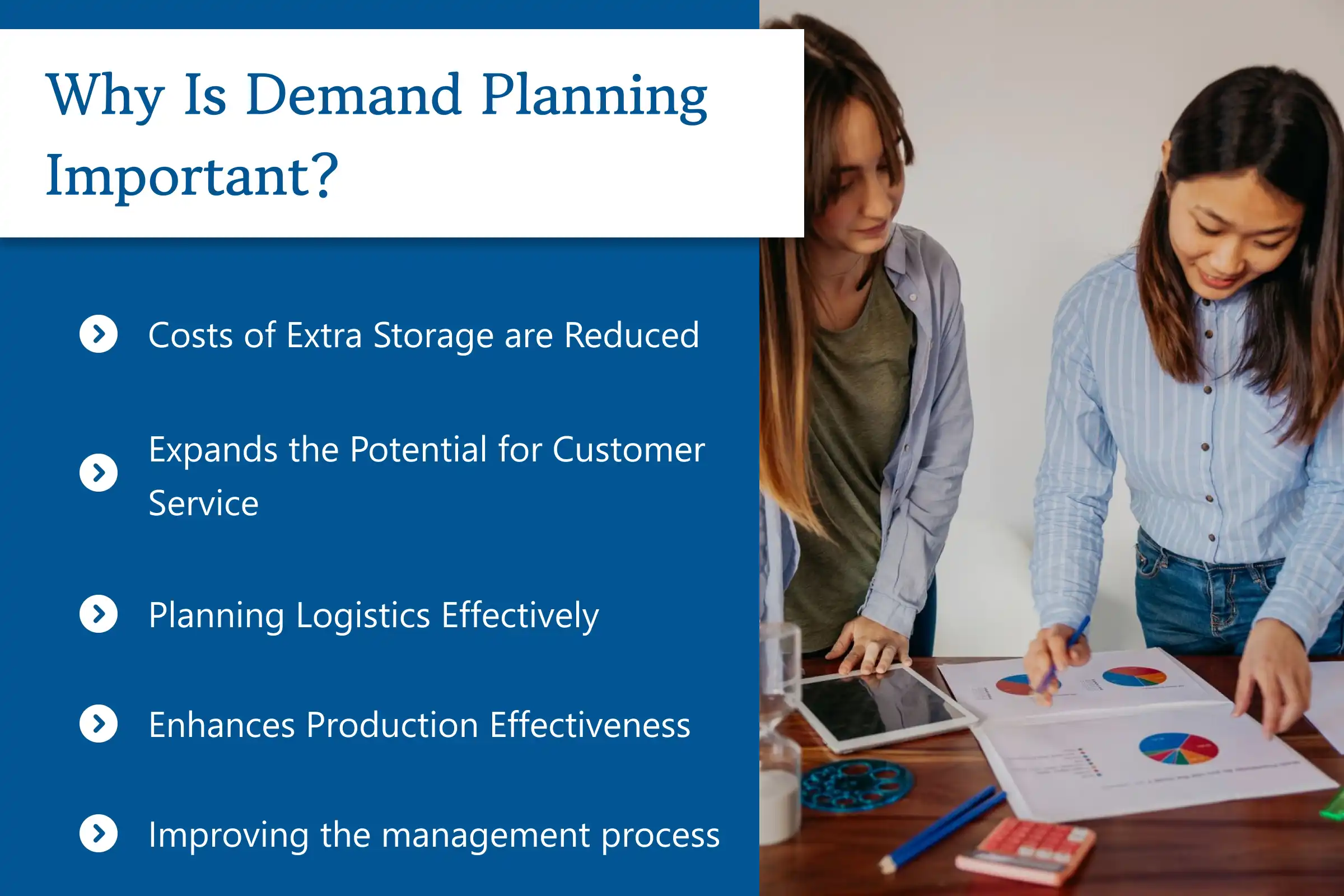How Demand Planning Can Improve the Supply Chain
Thousense Lite now makes it simple to implement a demand planning & demand forecasting solution that includes artificial intelligence and machine learning.

Demand forecasting often referred to as "demand prediction," is a procedure used in supply chain management to guarantee that products are offered to consumers in accordance with the demand at the appropriate time and location. Demand can be influenced by a wide range of variables, such as fluctuations in the labour force, economic changes, extreme weather, natural disasters, or world crises.
Supply chain
The network of people, businesses, resources, tasks, and technological advancements utilized to create and market a good or service is known as a supply chain. When raw materials are delivered from a supplier to a manufacturer and the final good or service is delivered to the customer, a supply chain has begun.
Supply chain management
It is the control of the exchange of goods and services, and it encompasses all processes that turn raw materials into completed goods. Maximizing customer value and gaining a competitive advantage in the market involves the purposeful streamlining of a firm's supply-side processes.
Optimum supply-chain practices
Managers of supply chains must adjust to the expanding scope and pace of the global market. For this, the following are best practices:
· Implement agile SCM and logistics strategies. Lean improves adaptability and reduces wasteful inventory.
· Boost inventory turnover: Businesses must make sure their production does not exceed the demand and that they can profit from scattered, rapidly shifting demand.
· Companies in their supply network must work together to optimize the entire thread, not just one corporation's operation. Relationships with suppliers are particularly crucial.
· Cut cycles short: Supply networks get longer and more intricate, and so do procedures. To satisfy client expectations, businesses should strive to keep them as brief as feasible.
· Implement supply chain technologies: Managers can more efficiently interact and integrate their supply chains thanks to technology.
· Establish meaningful metrics. Managers can precisely assess the chain's efficiency thanks to well-defined KPIs.
Why is Demand Planning important?
When establishing the effectiveness of a strong supply chain and enhancing its functioning, all parts of demand forecasting and planning are crucial. Striking a balance between having enough inventory to meet consumer demand without having excess is the objective.

Costs of Extra Storage are Reduced
A lack of demand planning and analysis can cause a company to lose its produced inventory because it will not be able to strike the correct balance between supply and demand. Demand planning is difficult but dynamic so it can be done accurately and effectively for every firm.
A thorough analysis that integrates planning and forecasting with the expected demand projections aids in the integration of a reliable supply chain. Planning and forecasting enable the supply chain management to reduce the high storage costs and have a favourable effect on revenue by providing the best analysis and projection.
Expands the Potential for Customer Service
Timely delivery and effective customer service are made possible by a strong as well as practical supply chain that is integrated and predicated on planning as well as demand forecasting.
Making the company credible and trustworthy eventually aids in accurate stock & inventory management forecasts. Demand planning enables good customer service by enabling the efficient fulfilment of client demand when sufficient information is accessible through research, study, and forecast.
Planning Logistics Effectively
It is simple for the business to use enough resources and precise stock inventories when it has a clear understanding of the future need through planning and forecasting. Increasing the effectiveness of logistics & forecasting aids in accurate planning, management, and efficient deployment of the appropriate resources.
Having the transport system easily accessible, robust logistics management based on demand forecasting, and an end-to-end effective integrated supply chain all contribute to lower transportation costs.
Enhances Production Effectiveness
After demand forecasting and project planning with the aid of the forecasted demand, it is simpler to concentrate on the numbers and implement a simple procedure. Planning assists in distributing capital toward optimum use, enhancing efficiency on a broad scale, and assisting the company in reducing overhead and additional expenditures.
Demand planning estimates the actual demand for the commodity from the marketplace, enabling it to easily close the gap between supply and demand by setting the correct schedule, meeting deadlines, and closely monitoring the production process.
Improving the management process
Enforcing the production chain with the information gathered from planning & market forecasting makes it simpler for the company to run the process effectively and improves its understanding of the market, consumers, and internal operations.
To achieve complete customer satisfaction, the completely integrated supply chain also takes into account the needs and feedback of the consumer. To put together a completely functional supply chain, a detailed study of demand planning, including market forecasts, and management procedures must be done.
Optimal Techniques for Demand Planning
Demand planning is indeed several processes that require the appropriate resources, knowledge, and procedures. Although there may occasionally be particular variations in the process depending on product placement, inventory requirements, and goals of the organization, the following are some best practices to bear in mind:
Use the Correct Software
Choosing the best enterprise resource planning (ERP) software can be challenging because there are so many options available. The ability of the software to handle forecasting nuances, as well as the provider's reputation, monitoring capabilities, and the openness and dependability of the forecasts it generates, everything be taken into consideration when selecting ERP software. For best results check out Artificial Intelligence based forecasting software Thousense.
Collect and make ready data
Demand planning is now greater than ever driven by data. More agile methodology modeling can be achieved with the use of real-time insight into inventory movements, metrics reporting that provides a clear picture, and data gathering and aggregating that can indicate areas for enhancement or reaction.
Construct Process Models
Chaos results from a lack of a clear demand planning cycle process. All too frequently, the process is confused with information, which is just a collection of publicly accepted facts about an organization. This hinders accountability and lowers performance.
The processes in the demand strategic planning often look something like this for most businesses:
1. Data Preparation
2. Initial projection
3. Utilizing market intelligence
4. To reconcile bottom-up projections with upper previous sales forecasts, consider sales objectives and financial data.
5. Finalize a forecast.
6. Real-time analytics-based performance monitoring
Implementing and Observing
Successful demand planners typically create a pilot edition of the plan utilizing descriptive analytics or historical data as a foundation. Additionally, they make regular revisions and utilize a team of individuals entirely responsible for developing the strategy, carrying it out, minimizing bias and mistakes, and building methods for execution.
Demand Forecasting in the Supply Network of the Future
Supply chain & demand forecasting are going digital, just like any company requirements. The supply chain can now adjust and update estimates instantaneously, allowing inventories to run more efficiently without underestimating demand, thanks to advancements in machine learning demand forecasting technologies.
Acknowledging how to develop new architectures and putting machine learning and artificial intelligence programs into practice that can help optimize a lean, agile, and information approach will open up new opportunities for professionals in supply chains to reduce operating costs, increase revenue, and provide a stronger competitive edge.
Demand planning may be done more quickly with a more integrated supply chain. Demand planning, when done correctly, can play a key role in increasing a supply chain's profitability.
Supply networks have a history of being more proactive than reactive. The capacity of your supply chain to adjust to changes in demand in the current market is more difficult than reacting to hidden order data. The current market's rising demand volatility makes the reactive model ineffective. In the contemporary marketplace, consumer demands and needs change more quickly, making it difficult for supply chains that really can adapt to these changes to exist.
By removing bias and constructing systems that can detect and react to demand fluctuation, successful supply networks can adapt. For an accurate prediction make the best use of the Thousense AI/ML-based demand forecasting tool.
